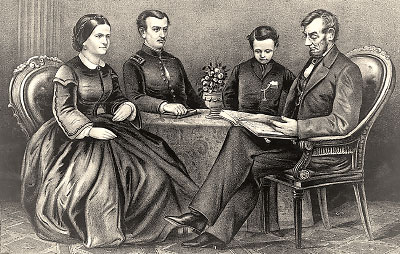The Lincolns: Retrospective Diagnosing Raises Questions Worth Pondering
Abstract
The case of Mary Todd Lincoln’s involuntary hospitalization especially highlights the difficulty of retrospective diagnosis, say two psychiatrist-historians.
Studying the putative psychiatric symptoms of Abraham Lincoln; his wife, Mary Todd Lincoln; and that of other historical figures raises fascinating and important questions about the nature of psychiatric diagnosis, how those diagnoses are viewed through various cultural lenses, and how they may change over time.
So said psychiatrists David Casey, M.D., and his son Brian Casey, M.D., both of the University of Louisville, at the APA 2019 Annual Meeting session “The Melancholy of the Lincolns: What We Can Learn About Psychiatric Diagnosis Through the Cases of the President and His Wife.”

This Currier & Ives lithograph depicts President Abraham and Mary Todd Lincoln and their sons Robert (second from left) and Thomas.
“The historical record may be incomplete or distorted, and the reporters may be biased,” said Brian Casey. “Manifestations of psychiatric disorders may change over time as cultures evolve—a concept that speaks to the culture-bound nature of syndromes.” And there is the problem of “reification,” which refers to the tendency to look for the familiar and attempt to fit an historical case into a contemporary paradigm.
Given the problems with retrospective diagnosis, David Casey suggested that the contemporary historian/clinician can render only the most tentative judgments. “I propose that only a general, syndromal diagnosis is usually supportable,” he said.
The father-son psychiatrists, both avid students of history, outlined the life stories of the Lincolns and what is known—or assumed—about their psychiatric symptoms. (David Casey is president of the Innominate Society of Louisville, a medical history society.)
Lincoln experienced a harsh childhood on the American frontier with a father who was physically abusive and disavowed his son’s scholarly ambitions. Lincoln suffered several traumas including the death of his mother and a beloved sister. He is believed to have experienced at least two prolonged periods of depressive symptoms—one after the loss of his sister and a second after breaking off his first engagement to Mary Todd.
He and Mary Todd Lincoln suffered the loss of a son, Edward, before he became president; and while they were in the White House—when Lincoln was presiding over a bloody civil war and the most tumultuous period in American history—they lost a second son, Willie. After her husband’s assassination, Mary Todd Lincoln suffered the loss of a third son, Thomas.
The case of Mary Todd Lincoln, who was involuntarily committed to an Illinois psychiatric hospital after the assassination, continues to attract controversy. She had long been a flamboyant character, and she exhibited delusional and suicidal behaviors, especially following the assassination. She has been retroactively diagnosed by some with bipolar disorder.
Independent of her symptoms, she was a controversial figure. The president’s wife was the daughter of a wealthy slaveholder, and she hosted the widow of a Confederate officer in the White House—for which she was widely condemned both in Washington, D.C., and throughout the North. Moreover, she had enemies in Congress who investigated her for spending lavishly on redecorating the White Hose. After Willie’s death, Mary held seances in the White House, inviting public ridicule.
Mary was committed to Bellevue Place in Illinois in 1875 by her son Robert with the help of several doctors who testified to her insanity. She was released four months later to the care of her sister Elizabeth.
Brian Casey said Mary Todd Lincoln’s case also has been viewed through the prisms of feminism and anti-psychiatry. More generally, her case raises the question: Can we really apply modern diagnostic constructs to historical figures?
“Our diagnostic ideas also evolve over time,” he said. “Applying DSM-1, -2, -3, -4, or -5 criteria may yield different opinions as to whether Mary Todd Lincoln did or did not have bipolar disorder, and Emil Kraepelin’s concept of manic-depression came long after Lincoln’s death. Recent publications and depictions of Mary reveal as much about the authors as the subject—including the application of modern views on psychiatry.” ■



